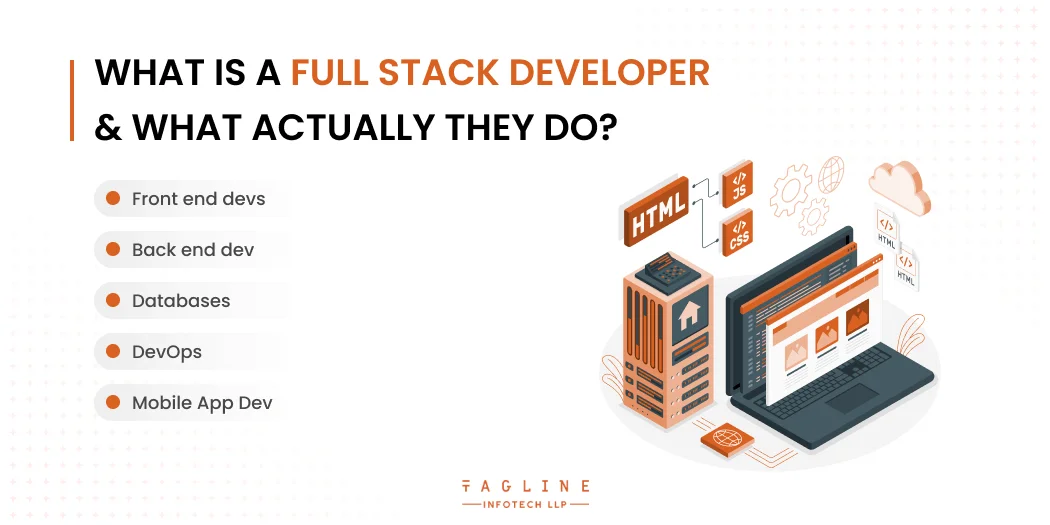Role of Python Libraries in Image Processing
October 30, 2025
Home >> Web Development >> What Is a Full Stack Developer & What Actually They Do?

If you are someone who is interested in the words ‘full stack web developer’ and wish to pursue it further this blog is for you. Continue reading if you are finding answers about what is full stack development, what is full stack developer, what is full stack and who are full stack professionals. The majority of professional coders are full-stack developers. Let us look further to know more about their tasks. There are many full stack developer languages used for server-side programming.

It is advantageous to have someone on the team who is a jack of all trades in the world of software programming especially when it comes to full-stack development. They are capable of assisting at various stages of development and have the versatility and time management skills to assist all levels of the development team. When it comes to web development, the Full Stack Developer is in charge. This person is not a Back End or Front End developer, but rather a “Full Stack” developer.

What is a full-stack developer? A Full Stack Professional/Developer is someone who works on both the Back End (or server-side) and the Front End (or client-side) of an application. To do their job well, Full Stack Developers must have some knowledge of a wide range of coding niches, from databases to graphic design and UI/UX management. They are like a swing, ready to help wherever they are needed in the process.
A Full Stack Developer’s responsibilities include the following:

A full stack developer is responsible for translating user requirements into overall architecture and implementing new systems. A Full-Stack Developer does not have to be an expert in every technology. However, when developing an application, the professional is expected to work on both the client and server sides and understand what is going on. He or she should be enthusiastic about all software technologies.

This skill set is concerned with the actual presentation of your website—how the information on your website is displayed in browsers and on mobile devices. Everything you see on a website—the layout, text and image positioning, colours, fonts, buttons, and so on—are all factors that the frontend developer must consider.
A dedicated front-end developer will be well-versed in HTML, CSS, and the scripting language JavaScript. The developer can use these languages to manipulate the information on a website in order to make it more appealing and effective.
A frontend developer’s main goal is to provide a platform for visitors to interact with, a platform that provides and receives information. This means that some developers will be familiar with web design and the use of software like Photoshop and Illustrator to create graphics and themed layouts. A frontend developer’s skill set may also include user experience design and user interface design, which help a team evaluate the best methods of displaying and collecting information. A frontend developer with these design skills is potentially more valuable because they can identify the look and feel of a site while also assessing its technical capabilities.

Backend development is commonly associated with processes such as data creation, editing/updating, and data collection. PHP, Ruby, and, perhaps most notably, Python development are examples of popular scripting languages. A backend developer can use these languages to create algorithms and business logic to manipulate data received from front-end development. This means that a backend developer must be able to write code to receive user input and save it somewhere, such as a database.
Databases are classified into two types: relational (such as PostgreSQL and MySQL) and non-relational management systems (like Mongo). SQL is the database management language that allows the developer to interact with the database. You can get started with it by reading our SQL primer. The concepts may appear foreign, but understand that there are various database management systems based on convenience and ease of use.
Backend development also includes server management applications, which host the database and serve the website. Using cloud-based platforms that provide infrastructure, such as Heroku or Amazon Web Services, as an alternative to knowing how to manage servers. Understanding server management enables a developer to troubleshoot slow applications and even determine the scalability of their websites to accommodate more users.

The average hourly cost to hire a full-stack developer at Tagline is $20, which may vary depending on the developer you choose for your product development. Furthermore, hiring a full-stack developer at Tagline costs around $2400 per month. Developers with 4 to 6 years of experience will be available to business owners.
There has never been a better time to become a Full Stack Developer, but you may be on the fence about how to break into the field. Whether you need to hone your skills and demonstrate your qualifications as a Full Stack Developer, or you simply want to make connections in your field, Tagline is the place to be!
A Full Stack Developer is a software engineer who works on both the client and server sides of a software application. This type of developer works on the Full Stack of a software application, which includes front-end development, back-end development, database development, server development, API development, and version control systems. As a result, the title "Full Stack" Developer was coined.

Digital Valley, 423, Apple Square, beside Lajamni Chowk, Mota Varachha, Surat, Gujarat 394101
D-401, titanium city center, 100 feet anand nagar road, Ahmedabad-380015
+91 9913 808 2851133 Sampley Ln Leander, Texas, 78641
52 Godalming Avenue, wallington, London - SM6 8NW